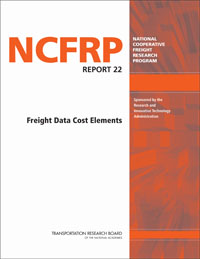Freight Transportation Cost Data Element
START YEAR: 2010
COMPLETION YEAR: 2012
TOPIC(S): Freight Modeling
PRIMARY CONTACT(S):
- José Holguín-Veras,
- Jeffrey Wojtowicz
PARTNER(S):
- Jack Faucett Associates, Inc.,
- A. Strauss-Wieder, Inc.,
- TNO
SPONSORS/FUNDING:
- The National Cooperative Freight Research Program Project 26 (NCFRP 26)

OVERVIEW
Freight Data Cost Elements identifies the specific types of direct freight transportation cost data elements required for public investment, policy, and regulatory decision-making. The report also describes and assesses different strategies for identifying and obtaining the needed cost data elements. The key objectives of the project are to:
- Identify the specific types of direct freight transportation cost data elements required for public investment, policy, and regulatory decision-making; and
- Describe and assess the different strategies needed to identify and obtain these cost data elements
KEY TASKS
- Identify and describe the state of the practice for current multimodal freight transportation cost data uses, sources, methods, collection strategies, and data elements for public-sector planning and decision-making
- Identify current and evolving public-sector freight transportation planning and decision-making functions and the cost data currently used, or that might be used, to support those functions. Describe the key freight transportation cost data elements required for public-sector planning and decision-making
- Identify primary and secondary freight transportation cost data sources and assess their applicability to the key requirements identified in Task 2. Discuss data issues and limitations, including data accuracy, privacy, antitrust issues and other constraints, as well as conceptual collection strategies. Discuss methods for closing any identified gaps
- Identify available cost estimation tools, methods, and procedures, and their applicability to the key requirements identified in Task 3. Discuss strengths and weaknesses and identify methods for closing any gaps
- Submit a final report that (1) identifies the specific types of direct freight transportation cost data elements required for public investment, policy, and regulatory decision-making and (2) describes and assesses different strategies for identifying and obtaining the needed cost data elements
KEY FINDINGS
- FG and FTG are very different concepts: their modeling approaches follow different principles
- Using constant FTG rates is bound to produce large estimation errors
- Employment and establishment area are good variables to explain FG and FTG
- The type of economic activity is a key variable to estimate FTG
- Industry sectors are better proxies of economic activities than land use
- The aggregation procedure should be determined according to the disaggregated model specification
KEY PRODUCTS
ADDITIONAL PRODUCTS
CONTRIBUTING TEAM MEMBERS
- Carlos González-Calderón
RELATED PROJECTS
